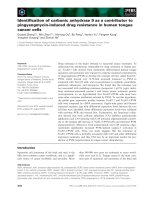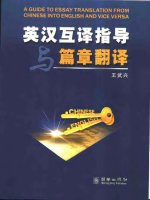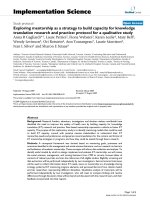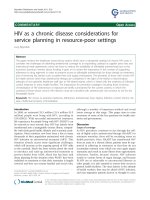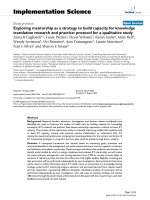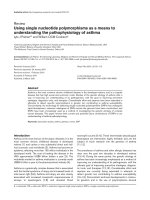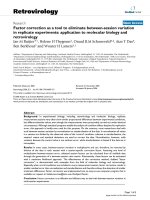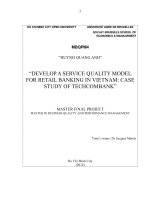Lesson Study as a Means to Innovation for Good Practices in Teaching and Learning Mathematics in Vietnam
Bạn đang xem bản rút gọn của tài liệu. Xem và tải ngay bản đầy đủ của tài liệu tại đây (123.55 KB, 10 trang )
VNU Journal of Science: Education Research, Vol. 30, No. 4 (2014) 31-40
31
Lesson Study as a Means to Innovation for Good Practices in
Teaching and Learning Mathematics in Vietnam
Trần Vui
*
ác
College of Education, Huế University, 34 Lê Lợi St., Huế, Vietnam
Received 10 July 2014
Revised 20 October 2014; Accepted 08 December 2014
Abstract: This paper will demonstrate that lesson study may be adapted from its primary use as a
professional development strategy to an effective means for good practices in teaching and
learning mathematics. Having launched the National Standard Mathematics Curriculum in
Vietnam in 2006, classroom mathematics teachers have learnt more about innovative teaching
strategies as a means of implementing more effective lessons, focusing on mathematical thinking.
The aim of this paper will be to try to answer four questions related to innovations and good
practices in mathematics classrooms. Firstly, how does lesson study as a means of innovation
affect the teaching and learning of mathematics? Secondly, how does this innovation affect the
improvement of student learning? Thirdly, how does lesson study support the professional
development of teachers and, finally, how does the use of innovation in teaching and learning
mathematics affect the implementation of curriculum reform? Research findings of the study will
shed light on the relative contribution of lesson study in both the teaching and learning of
mathematics with main focus on higher order thinking.
Keywords: Good practices; lesson study; professional development; school reform mathematics;
teaching and learning mathematics.
1. Introduction
*
In Vietnam, since the emphasis of the old
mathematics curriculum was on procedural
knowledge and memorization of algorithms,
students often worked independently to
complete exercises from textbooks and
workbooks. When asking students questions,
most teachers seek one “right” answer to the
mathematical problem and will explain why
that answer is correct. The reform curriculum
tries to reduce the amount of basic skills and
procedures in mathematics, while increasing
_______
*
Tel.: 84-54-3824244
Email:
hands-on activities that help students to grasp
new ideas and develop mathematical thinking.
School reforms in mathematics education aim
to help students achieve the following four
objectives: knowledge, skills, thinking and
attitudes (MOET, 2009).
In the regulation of professional standards
for school teachers, there is a section on the
application of teaching methods which
promotes students’ positivity, perseverance and
creativity, as well as enhancing their self-
motivation and thinking (MOET, 2009). It is
new innovations in teaching and learning
methods in mathematics that needs to be
encouraged. The teacher ought to think of
T. Vui / VNU Journal of Science: Education Research, Vol. 30, No. 4 (2014) 31-40
32
teaching in terms of several principal hands-on
activities, problematic real-life situations, and
open-ended questions. This innovation in
teaching should help students construct their
own knowledge in an active way, and enhance
their higher order thinking through solving
non-routine problems while working
cooperatively with classmates, so that their
talents and competencies are developed (Tran
Vui, 2006a, 2006b).
There are several possibilities for the
innovation of mathematics education in an
economy. Lesson study has its origins in Japan
where it has been used as the primary means of
professional development for teachers, for
comprehensive details of Japanese lesson study
see Isoda, Stephens, Ohara & Miyakawa
(2007). Lesson study is currently a central
focus in the United States and other economies,
where it is being used in innovative ways to
enhance good practices in actual classrooms
and to help towards the development of
students’ mathematical ideas. Lesson study has
also been credited with dramatic successes in
improving classroom practices within the
elementary school system (Lewis, 2002).
The aim of this paper is to report on how
lesson study was used as a means of
innovations in teaching and learning
mathematics in Vietnam.
2. Literature review
2.1. Lesson Study
The concept of lesson study seems simple
and obvious: if education needs to be improved,
then teachers need to be introduced to the
processes of teaching and learning in
classrooms, and then they need to devise ways
to improve them. Remarkably, lesson study is
not only a means of improving the skills and
knowledge of teachers, but also a way to
improve the knowledge base of the teaching
profession. Japanese teachers are not only
meeting in groups to improve teaching and
learning, but writing books for other teachers in
order to share what they have learned from
practices (Fernandez & Yoshida, 2004).
A particularly noticeable accomplishment
in recent years of lesson study in Japan has
been the transformation from teacher-directed
instruction to student-centered instruction in
mathematics and science education. The
success of lesson study can be found in two
primary aspects: improvements in teacher
practice and the promotion of collaboration
among teachers (Takahashi, 2006).
In this research paper, a lesson study cycle was
adopted that comprised four stages: planning →
implementing and observing → discussing and
reflecting → revising.
Teaching school mathematics aims to equip
students with basic mathematics, and develop
and nurture their mathematical thinking to solve
real life problems. Many teachers in Vietnam
really need a practical framework within their
classes to develop the student mathematical
thinking. Of course, each country has a slightly
different approach to teaching mathematics, but
there are still many commonalities that can be
shared, so that a realistic framework can be
constructed which can help classroom teachers
in each ASEAN country.
The research focuses on lesson study as a
means to innovation for good practices in
mathematics classrooms. The results from this
research on lesson study show that good
teaching practices are powerful models for
changing the quality of mathematics education.
T. Vui / VNU Journal of Science: Education Research, Vol. 30, No. 4 (2014) 31-40
33
2.2. Well-constructed Lesson Plans: a
Vietnamese Approach
Classroom teachers know how to design
lesson plans and this is reflected in the
ability to identify the right objectives,
contents of the lesson, intended teaching
strategies and aids, and appropriate
allocation of time, according to lesson flow.
In the teaching standards, the components
for developing a well-constructed lesson
plan are defined as follows (MOET, 2009):
- The teacher designs a lesson plan, in
accordance with regulations, on the
subject structure;
- Lesson plans must suitably reflect the
objectives of the lessons;
- Lesson plans are consistent throughout the
major content of the lesson;
- Lesson plans present a selection of
teaching methods to facilitate the students’
learning initiative;
- Learning materials, aids and resources
are selected and used effectively to improve
teaching quality;
- Assessment tools and methods are
included in lesson plans;
- Timing for teaching activities in the
classroom must be clearly indentified in the
lesson plans.
In the guidebook for mathematics teachers
there are four main activities in a lesson at each
grade that teachers should follow to develop
mathematical thinking:
Activity 1. The teacher motivates students to
work and achieves the following aims:
- Examining the students’ previous knowledge;
- Consolidating previous knowledge
involved with the new lesson;
- Introducing the new lesson.
Activity 2. The teacher facilitates the
students’ exploration of mathematical
knowledge and allows them to construct new
knowledge by themselves.
Activity 3. Students practice the new
knowledge by solving exercises and problems
in the textbook.
Activity 4. The teacher reviews what the
students have learnt in the new lesson and
assigns the homework.
Engaging with the lesson will give students
an opportunity to demonstrate their
mathematical thinking through:
- Lhe ability to observe, predict, and apply
rational and logical reasoning;
- Knowing how to express procedures and
properties through language at specific levels of
generalization (by words, word formulae);
- Knowing how to investigate facts,
situations, and relationships in the process of
learning and practicing mathematics;
- Developing the ability to analyse,
synthesise, generalise, specify, and start to think
critically and creatively (MOET, 2006).
2.3. Types of lessons that support the curriculum
From the curriculum and textbooks
lessons can be categorized into two main
types as follows:
a) New lessons
- Help students pose, explore and solve problems
The teacher facilitates the students in
posing questions, and exploring problems when
they engage in a problematic situation. The
teacher then enables the students to mobilize
what they have experienced and learnt, in order
to search for and recognize the relationship
between the posed problem and their accepted
knowledge for the ultimate purpose of
T. Vui / VNU Journal of Science: Education Research, Vol. 30, No. 4 (2014) 31-40
34
developing an appropriate strategy to solve
the problem.
- Give the students opportunities to
consolidate and apply their constructed
knowledge after learning the new lesson, so that
they can start to absorb the new information
After a new lesson in the mathematics
textbook, there are usually three exercises that
students can use to consolidate and practice
what they have learnt in the lesson. The two
first exercises require students to have an
appreciation of how to practice and directly
apply the new knowledge, while the third is
usually a problem which requires the indirect
application of the new knowledge.
b) Consolidation, practice and general
practice lessons
- Help students recognize learnt and new
knowledge in various problems.
- Help students practice within the sphere of
their individual capabilities.
- In small groups, give students the
opportunity to assist one another by effectively
interacting through the use of worksheets.
- Help students form the habit of checking,
and evaluating their work.
- Help students form the habit of finding
various strategies and choosing the most
appropriate for problem solving.
2.4. Open-ended problems
Pehkonen (1997) states that problems dealt
with in school mathematics are usually closed
problems, which do not leave much room for
creative thinking. The idea of using open-ended
problems to improve school mathematics
teaching, to develop and foster methods for
teaching problem-solving and thinking skills,
has appeared in the curriculum of many
countries in a form that allows teachers the
freedom to adopt an “open approach”
(Pehkonen, 1997; Foong, 2000). Nohda (2000)
holds the view that open-ended problems are
atypical and should have two prerequisites.
Firstly, they should suit every single student by
using familiar and interesting subjects. This
implies that students realize it is necessary to
solve the problems, feel it possible to solve
them with their own knowledge and have a
sense of achievement after having solved them.
Therefore, the problems should be sufficiently
flexible to take into account the students’
different mathematical abilities. Secondly,
open-ended problems should be suitable for
mathematical thinking and it should be possible
to restructure them into new problems.
The open-ended problems give students
good opportunities to discover new
mathematical ideas. Since the discovery of new
mathematical knowledge alone does not
guarantee certainty, the hypothetical knowledge
has to be verified. To express a discovery only
means an explanatory hypothesis is becoming
plausible. Nevertheless, the correctness of the
rule and the case, as well as the coherence
between the rule and the observed fact, could
remain vague (Meyer, 2007, 2010).
3. This Study
3.1. The Research Lesson
In the study reported here, the focus is on
the exploration of good practices that lead to the
designing of well-constructed lessons, using
open-ended problems to promote student
discovery of new mathematical ideas. Since the
Vietnamese secondary mathematics teachers
who were involved in this research were not
familiar with the use of lesson study to improve
their good practices in actual classrooms, a
workshop on “Lesson study as a means to
T. Vui / VNU Journal of Science: Education Research, Vol. 30, No. 4 (2014) 31-40
35
innovation of teaching and learning
mathematics” had to be conducted first. Twelve
teachers, including one specialist in
mathematics, attended this workshop, and
most of them were from a secondary school
in Hue City, Vietnam. The objectives of the
workshop were:
- Helping teachers how to use lesson study
as a means to innovation of teaching and
learning mathematics;
- Helping teachers how to use the
innovation to improve student learning;
- Discussing with teachers how the lesson
study should support the professional
development of teachers;
- Helping teachers how to use innovation in
teaching and learning mathematics to
implement the reform national mathematics
curriculum;
- Selecting two well-known and
experienced teachers to prepare and implement
the lesson plans in the classroom as a future
observation and discussion tool.
At the end of the workshop, a group of
teachers was formed to participate in this study.
This first team worked as a research group to
create the lesson plans, worksheets and
instructional materials suitable for the units
selected from the reform mathematics
curriculum for grade 7 in Vietnam (Ton Than,
2003). The lessons chosen by the teachers were
taken from the national text book. The teachers
agreed in the meeting that these lessons are too
difficult and abstract for the students. The
presentations of these lessons in the text book
are not relevant to students. Traditionally, the
definitions are merely stated, and students have
to accept these new mathematical concepts
from the text book without any real
understanding. In this research, teachers
created problematic situations to help
students explore new mathematical ideas and
concepts more profoundly.
3.2. Objectives
The study aimed to explore and investigate
the implementation of lesson study as a means
to encourage good practice in teaching and
learning of selected topics in lower secondary
mathematics in Vietnam.
The research sought to find answers to the
following questions:
- How does the innovation affect the
improvement of student learning?
- How does the lesson study as a means
to innovation affect the teaching and
learning of mathematics?
- How does the use of innovation in
teaching and learning mathematics affect the
implementation of the reform curriculum?
- How does the lesson study support the
professional development of teachers?
The findings of the study will shed light on
the relative contribution of the lesson study
as a means to innovation of the teaching
and learning of mathematics.
3.3. Methodology
The study was conducted in two school-
years. All teachers were introduced to lesson
study for the first time at the research
workshop. The methodology of the research was
also explained and discussed at the workshop, i.e.
it was made clear that the teachers were
responsible for their own use of innovation and
good practice in teaching mathematics. What was
required of them were observations on the things
which happened in their classes and their
reactions to the innovation.
Four classes were involved in the research.
The study involved grade 7 students with ages
T. Vui / VNU Journal of Science: Education Research, Vol. 30, No. 4 (2014) 31-40
36
ranging from 12-13 years. Overall a total of 185
students and 8 teachers were involved in the
study. The lessons covered some selected units
in geometry at grade 7.
To prepare the lesson plans, the role of
these units in the curriculum and how they were
usually taught was considered and discussed.
Teachers agreed that the lesson plans should
have some of the following characteristics:
- The mathematics content taught should
be meaningful;
- The thinking processes of students should
be obvious in their answers, products, and
presentation and that anyone watching the video
should be able to recognise them.
- The innovation in teaching and learning
should be discussed, and prepared in the
mathematics division of the school. Every
teacher in the division should have his/her own
contribution to the innovation.
- The lesson should use instructional
materials that are innovative and appropriate to
the school.
The teachers who were to implement these
lesson plans were chosen by teachers in the
division. They already had experience of
creating problematic situations and asking
open-ended questions that required
mathematical thinking of the students.
The lessons were videotaped and analyzed
using the video recording and the transcript.
The actual lessons included several open-
ended activities.
4. Research Findings
These lesson plans designed by senior
teachers were implemented in four different
classes before filming. In the first classes, there
were seven observers, who were mathematics
teachers at the school. Through discussion,
teachers found out that the lesson plans needed
to be changed in some places to help the
students answer the open-ended questions in
problematic situations. Some questions were
not clear and were too general, so students did
not feel confident enough to answer. Some
questions merely required a good memory and
recall and students were not interested in
answering these. The lesson plans were
consequently revised and taught in other
classes. In the second classes teachers observed
students folding, drawing and measuring and
discovered that students exhibited good
responses to questions and actively engaged in
the tasks. This time, the teachers agreed that the
lesson plans and their progression suited the
students in every grade 7 class. The lessons,
however, still required revision. It was then
decided, in the third round, for the purposes of
filming, to implement the revised lesson plans
in two actual classes. The students’ responses to
instructional activities at both consideration and
evaluation points were recorded and analysed.
There were thirteen mathematics teachers
observed in the classes. After observing the actual
classes, a meeting was organised in order to share
ideas and provide feedback. During the meeting,
the teachers gave a lot of comments about four
main issues with corresponding research
questions and these were recorded as follows.
4.1. Lesson study as a means to innovation
In the lesson study teachers played a central
role in deciding on the innovation in teaching
and learning. They were the ones to implement
the innovations in their actual classrooms.
Teachers helped each other to improve
mathematics instruction in the classroom. The
innovation can be shared with other teachers.
What was the innovation in teaching
method that appeared in the lessons?
T. Vui / VNU Journal of Science: Education Research, Vol. 30, No. 4 (2014) 31-40
37
There were many answers to this question:
- Lessons started with some real life
situations by asking students to investigate
open-ended problems rooted in real contexts.
The learning process involved all students
working in small groups.
- Students actively sought and explored
mathematical knowledge with the help of
the teacher.
- The teacher used a means of posing a
problem that was based on a real-life situation
to engage the students’ interest at the beginning
of the lesson.
- The lesson was student-centered, and
required cooperative learning. From a
problematic real-life situation, the teacher
facilitated the students to seek for and construct
new knowledge.
- The students actively worked with
mathematical problems.
- The teaching was innovative; it differed
from the old approach of merely ‘lecturing’.
4.2. The improvement of students’ learning
Good practice as a means of improving
student learning is being pursued. The good
practice exhibited in this lesson study is based
on actual outcomes of successful student
learning, including students’ mathematical
thinking, and can be used for further
development.
Was the mathematical content taught in the
lesson meaningful and realistic?
- Students understood the relationship
between mathematics and real life.
- By folding papers, and measuring lengths
on the papers, students explored some
properties of geometric figures.
- The lesson started within a real life
scenario with the aim of developing meaningful
mathematics knowledge and then students
adapted the constructed knowledge to suit the
real life situation.
- A mathematical concept was generated
from a familiar situation in the real world. The
information thus constructed helped students
solve real-life problems.
- Students felt that there was really a link
between mathematics and real life.
How were the key points intended to
enhance students’ mathematical thinking
demonstrated in the lessons?
- Students demonstrated good responses
to the questions, but it depended on the
ability of each class as to the appropriateness
of the questions.
- Students practiced measurements, induced
from concrete data to generalize the
mathematics properties.
- The open-ended questions gave students a
chance to explore the property of three medians
by themselves.
- Students commented positively on some
mathematical ideas. .
- Students understood the problem solving
process for real-life situations.
How was students' ability in responding to
the questions and tasks requiring mathematical
thinking reflected in the lessons?
- The tasks and questions were relevant to
the students’ previous knowledge, so they felt
confident in seeking new information.
- Most of students applied mathematical
reasoning to explain any new knowledge
they found.
- Students then had to provide a logical
breakdown of their results.
T. Vui / VNU Journal of Science: Education Research, Vol. 30, No. 4 (2014) 31-40
38
4.3. Lesson study supports the
professional development
How did the instructional materials support
the lesson?
- The instructional materials greatly assisted
the lessons, and supported students in exploring
and discovering new information.
- Low-cost instructional materials such as
paper, and grid paper, combined with modern
computers, helped students successfully explore
mathematical ideas.
- The teacher used many kinds of instructional
materials that helped students explore
corresponding mathematical ideas effectively.
- An in-service training course for
developing instructional materials is required,
especially for computer software.
How did the interaction student -
student - teacher show in the
communication and discussion?
- The students worked in small groups with
the guidance and evaluation of their teacher.
Hints from the teacher were effective in
discussions between the students.
- Some students were shy and hesitant when
sharing their knowledge with friends.
What should be changed in the lesson to
improve the learning study next time?
- One student should have a separate set of
activities, so they can independently manipulate
the object to explore mathematical ideas.
- These lessons can be applied broadly to
other classes, but the professional ability of the
teachers needs to be improved the students’
assessment needs to be reformed.
4.4. Innovation in the implementation of the
reform curriculum
How was the thinking process of students
demonstrated when doing specific
mathematical tasks in the lesson that were
identified in the reform curriculum?
- Students had to accurately explore the
mathematical properties of the triangles by
observing, folding, measuring and inducing.
- Students could apply what they had
learnt to solve some specific problems posed
by the teacher.
- Most of the students showed that they
understood the lessons, and solved the problems
set by the teachers. These problems were
revised from the text books.
What were the outcomes of the application
of these lesson plans in the curriculum of lower
secondary mathematics?
- With some schools having good facilities
such as computers, and projectors these lesson
plans will be very effective.
- This lesson study should be applied to
other topics and classes.
- The curriculum is still too overcrowded,
with teachers having to deliver a lot of the
content knowledge from text books. Time
constraint is, therefore a big issue if all students
are to work at their own paces.
- Relevant facilities must be provided if
schools are to prepare appropriate instructional
materials for specific topics in the curriculum.
- The practical theories that help
classroom teachers develop good practices
which are relevant to the reform curriculum
need to be implemented.
5. Conclusions
The lesson study cycle was introduced in a
secondary school in Vietnam. All mathematics
teachers in the school agreed that lesson study
provided them a good opportunity to see
teaching and learning in a classroom scenario.
T. Vui / VNU Journal of Science: Education Research, Vol. 30, No. 4 (2014) 31-40
39
From that actual scenario teachers developed
innovative teaching practices to help student
learning. The use of this innovation for the
teaching and learning of mathematics in the
classroom must be implemented to engage
students in meaningful mathematical tasks that
require higher order thinking. The innovation
provides all students access to a broad range
of mathematical ideas. Specifically, the
research sought to find answers to the
research questions.
Lesson study guides teachers in focusing
their discussions on getting the effective
innovation through the cycle. By discussing and
sharing new ideas on good practices, observing
what happens in the actual classroom, teachers
improve their teaching and consequently
enhance the students’ learning. Lesson study
can be applied to many topics in the reform
curriculum. Lesson study as a means of
innovation, actively affected to teaching and
learning of mathematics in the school.
The innovation as a product of the lesson
study helps students have a better and more
meaningful understanding of difficult
mathematical concepts. Students were able to
discuss and interact freely within their groups
while answering relevant open-ended questions.
The students communicated amicably while
they were engaged in the mathematics
activities. With hands-on activities, students
always have something to share with their
friends about any problems involving with
mathematical thinking. For giving them the
opportunities to come up with new
mathematical ideas as possible solutions for a
non-routine problem rooted from real life, the
students were exposed to a problematic
situation they could not solve with their former
knowledge. They had to construct new ideas as
plausible solutions (Tran Vui, 2014).
The lesson study as a means to innovation
for good practice in teaching and learning
mathematics actually supported the professional
development of teachers. Teachers learnt some
new things from their peers and can now apply
them to the teaching of mathematics. The
reform mathematics curriculum requires
students to learn mathematics in an active way
to enhance mathematical thinking, so the
innovation in teaching and learning
mathematics can help teachers implement the
curriculum effectively.
References
[1] Fernandez, C., Yoshida, M. Lesson study: a
Japanese approach to improving mathematics
teaching and learning, Lawrence Erlbaum
Associates, Inc, 2004.
[2] Foong, P., Y., Open-ended problems for higher-
order thinking in mathematics, Teaching and
Learning, 20(2), January, 2000.
[3] Isoda, M., Stephens, M., Ohara, Y., &
Miyakawa, T., Japanese lesson study in
mathematics. Its impact, diversity and potential
for educational improvements, Hackensack, NJ:
World Scientific, 2007.
[4] Lewis, C., Lesson study: A handbook of
teacher-led instructional improvement,
Philadelphia: Research for better schools, 2002.
[5] MOET, Mathematics Standard Curriculum,
National Publishing House, Hanoi,
Vietnam, 2006.
[6] MOET, Regulation on professional standards
for teachers at junior and senior secondary
schools, The Ministry of Education and
Training, Circular No. 30/2009/TT-MOET,
Hanoi, 2009.
[7] Meyer, M., From discoveries to verifications -
theoretical framework and inferential analyses
of classroom interaction, TU Dortmund,
Germany, 2007.
[8] Meyer, M., Abduction: A logical view for
investigating and initiating processes of
discovering mathematical coherences, Educ
Stud Math (2010) 74:185-205, Published online,
Springer Science & Business Media, 2010.
T. Vui / VNU Journal of Science: Education Research, Vol. 30, No. 4 (2014) 31-40
40
[9] Nohda, N., Teaching by open-approach method
in Japanese mathematics classroom, Proceeding
of the 24th Annual Conference of International
Group for the Psychology of Mathematics
Education, 1 (2000) 39.
[10] Pehkonen, E., Use of open-ended problems in
mathematics classroom, Research Report 176,
Helsinki Uni., (Finland), Dept, of Teacher
Education, 1997.
[11] Takahashi, A., Implementing lesson study in
north American schools. Proceedings of APEC
International Symposium on Innovation and
Good Practice for Teaching and Learning
Mathematics through Lesson Study, Khon Kaen
Session, Thailand 14-17 June, 2006
[12] Ton Than, Mathematics Grade 7, Volume 2.
Publication House, Ministry of Education and
Training, Hanoi, 2003.
[13] Tran Vui, Using lesson study as a tool to develop
profession of mathematics teachers, Journal of
Education, Vietnam, No. 151 (2006a) 18.
[14] Tran Vui, Helping students develop and extend
their capacity to do purposeful mathematical
works, Tsukuba Journal of Educational Study in
Mathematics, Vol. 25 (2006b) 279.
[15] Tran Vui, Investigating arithmetic mean,
harmonic mean, and average speed through
dynamic visual representations. J. Korean Soc.
Math. Educ, Ser. D, Res. Math, Educ., Vol. 18
(2014) 231.
Nghiên cứu bài học làm phương tiện đổi mới các thực hành tốt
trong dạy và học Toán ở Việt Nam
Trần Vui
ác
Trường Đại học Sư phạm, Đại học Huế,
34 Lê Lợi, Huế, Việt Nam
Tóm tắt: Bài báo này minh chứng rằng nghiên cứu bài học có thể được thích ứng từ việc sử dụng cơ
bản của nó như là một phương án phát triển nghề nghiệp đến một phương tiện hiệu quả cho những thực
hành tốt trong dạy và học toán. Kể từ khi chương trình toán chuẩn quốc gia của Việt Nam được ban hành
năm 2006, các giáo viên toán đã học được nhiều hơn về các phương án dạy học tiên tiến như là phương
tiện để thực hiện càng nhiều các bài học hiệu quả đặt trọng tâm vào tư duy toán học. Mục đích của bài báo
này là để trả lời bốn câu hỏi liên quan đến những đổi mới và thực hành tốt trong lớp học toán. Thứ nhất,
nghiên cứu bài học như là một phương tiện để đổi mới có ảnh hưởng như thế nào đến dạy và học toán? Thứ
hai, đổi mới này ảnh hưởng như thế nào đến việc nâng cao việc học của học sinh? Thứ ba, nghiên cứu bài
học hỗ trợ việc phát triển nghề nghiệp của giáo viên như thế nào? Cuối cùng, việc đổi mới dạy và học toán
có tác động như thế nào lên việc thực hiện đổi mới chương trình? Các kết quả của nghiên cứu này sẽ làm
sáng tỏ những đóng góp mang tính tương đối của nghiên cứu bài học ở cả việc dạy và việc học toán với
trọng tâm chính là tư duy bậc cao.
Từ khóa: Thực hành tốt; nghiên cứu bài học; phát triển nghề nghiệp; toán học nhà trường đổi mới;
dạy và học toán.
